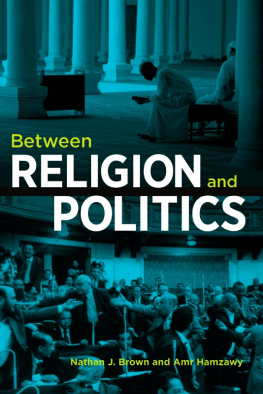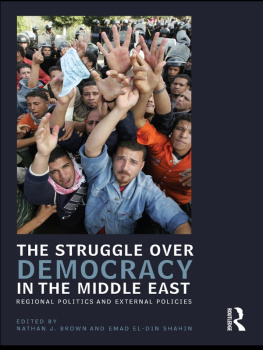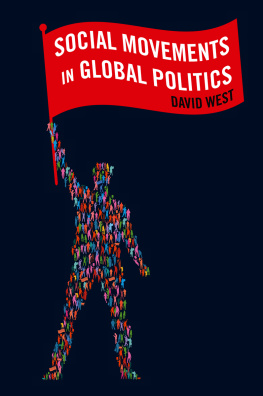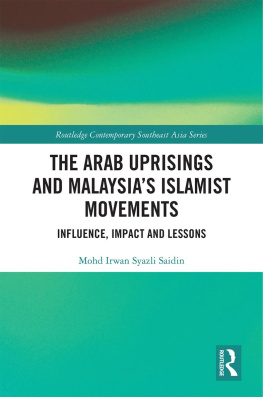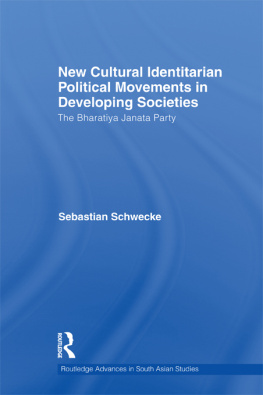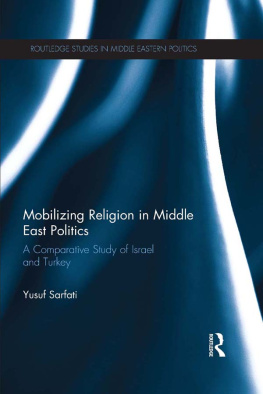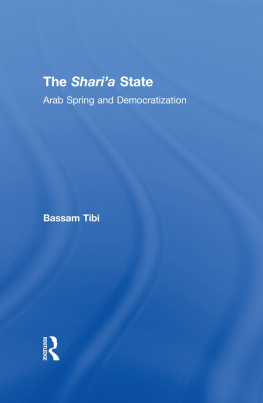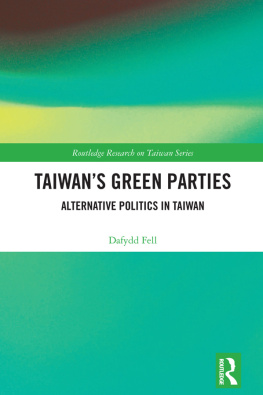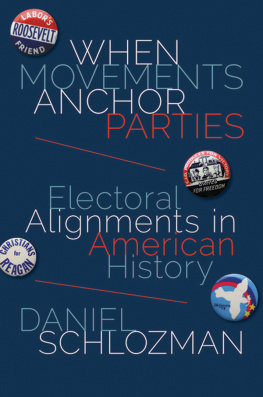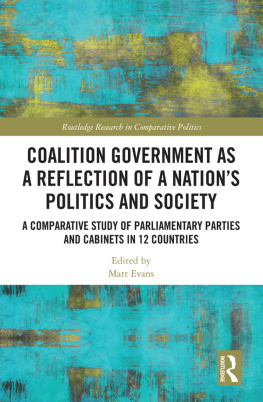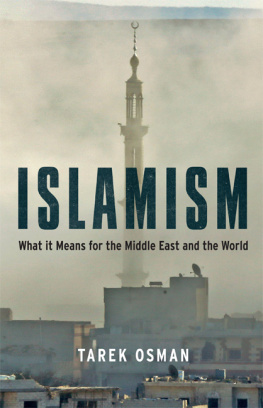
2010 Carnegie Endowment for International Peace. All rights reserved.
No part of this publication may be reproduced or transmitted in any form or by any means without permission in writing from the Carnegie Endowment.
Carnegie Endowment for International Peace
1779 Massachusetts Avenue, N.W., Washington, D.C. 20036
202-483-7600, Fax 202-483-1840
www.CarnegieEndowment.org
The Carnegie Endowment does not take institutional positions on public policy issues; the views represented here are the authors own and do not necessarily reflect the views of the Endowment, its staff, or its trustees.
To order, contact:
Hopkins Fulfillment Service
P.O. Box 50370, Baltimore, MD 21211-4370
1-800-537-5487 or 1-410-516-6956
Fax 1-410-516-6998
The Carnegie Endowment for International Peace gratefully acknowledges the United States Institute of Peace for its generous support of this publication.
Library of Congress Cataloging-in-Publication Data
Brown, Nathan J.
Between religion and politics / Nathan J. Brown and Amr Hamzawy.
p. cm.
ISBN 978-0-87003-255-4 (pbk.) ISBN 978-0-87003-256-1 (cloth) ISBN 978-0-87003-297-4 (e-Book)
1. Islam and politicsMiddle East. 2. Islam and politicsIslamic countries. 3. Islamic fundamentalismMiddle East. 4. MuslimsPolitical activityMiddle East. 5. Political participationMiddle East. 6. Middle EastPolitics and government21st century. I. Hamzawy, Amr. II. Title.
BP63.A35B48 2010
324.2091767dc22
2010016117
O ver the past decade, Islamists have been thrust by events and by their own efforts into the center of the political stage in a number of Arab countries. The parties and movements that Nathan J. Brown and Amr Hamzawy consider in this volume are not ones that form small cells for violent actions. Rather, they are large, diverse organizations that seek (among other things) to participate in the established political process.
The various parties and movements considered herein Egypt, Morocco, Yemen, Jordan, Palestine, and Kuwaitare hardly new. Most go back decades. But in recent years, all have taken a much stronger interest in electoral competition and parliamentary politics. It is the initial success of these efforts that has earned them so much attention in the Arab world and abroad. In Egypt, the Muslim Brotherhood won one-fifth of the seats in the 2005 parliamentary elections. In Morocco, the Party for Justice and Development earned more votes than any other party in the 2007 parliamentary elections (though because of the electoral system it finished second). The Palestinian Hamas movement won the first parliamentary elections it entered in 2006. In Yemen, Jordan, and Kuwait, Islamist parties and movements have been slower but steadier players; in each country they have also experimented with sitting in the government and trying to form opposition coalitions.
In Between Religion and Politics, Brown and Hamzawy delve into the parliamentary experience of Islamists: What made them decide to step up their involvement in parliamentary politics? What did they do with the seats they won? How has the Islamists embrace of parliamentary elections affected their relations with the regime? Have they managed to build coalitions with other political actors, especially liberal and leftist parties? And how are they likely to react to the ebbing tide of democratization in the region?
The essays in this book explore a kind of in between politicsregimes playing with democratic procedures without being fully committed to them and Islamists investing in political participation without sacrificing their broad focus on religious and social activism. And although the long-term impacts of this political gray zone remain to be seen, it has already injected elements of dynamism and competition into what was otherwise a persistently stagnant polity in the Arab world.
Jessica T. Mathews
President, Carnegie Endowment for International Peace
T his book represents a collaboration in two senses.
First, it is a collaboration between the two authorsone in which each of us has contributed our own interests and expertise individually but also enriched each others understanding of the role of Islamists in Arab politics. The resulting work is therefore more than the sum of each of our individual parts. While we both share responsibility for the final product, we should note that Amr Hamzawy contributed the chapters on Morocco and Yemen; Nathan J. Brown wrote those on Kuwait, Jordan, and Palestine. The introduction, conclusion, and Egypt chapter are joint efforts.
Second, the book signifies a different kind of collaborationthat between its authors and a collection of institutions and individuals who contributed their own efforts and support to the project.
In that regard, we wish to acknowledge two institutions: the Carnegie Endowment for International Peace, where we both serve as senior associates; and the United States Institute of Peace (USIP), which contributed vital funding to the project. Carnegie has provided both material support and a very genial research environment. USIP grant support made possible a good portion of the research and writing of the country studies. Of course, the conclusions in this book are only our own and do not represent the institutional positions of Carnegie or USIP.
On an individual basis, three officials at Carnegie deserve special mention: Tom Carothers (for reading drafts and editorial suggestions), Marina Ottaway (for research cooperation and endless discussions on the topic), and Ilonka Oszvald for gracefully combining patience with speed in dealing with all the editorial and publishing issues. At USIP, Steve Riskin has been extremely supportive, especially on matters requiring cooperation between USIP and Carnegie.
Conversations with many colleagues have helped sharpen our thinking on the subject of this book. At the risk of omitting many names of those whose own insights shaped our understanding, we make special mention of Janine Clark, Michele Dunne, Shadi Hamid, Marc Lynch, Michael McFaul, Samer Shehata, Amr al-Shubaki, Josh Stacher, Hussam Tamam, and Carrie Rosefsky Wickham.
And we have incurred more debts as well. We have received invaluable assistance in our research from Dina Bishara, Russ Burns, Andrew Clark, Sarah Grebowski, Jessica Guiney, Mohammed Herzallah, Bassam Moussa, Khaled Waleed, and Diane Zoghivian.
We would be remiss not to mention activists in the movements themselves, who gave very generously of their time in order to provide us with their views on their own political experience.
Finally, we dedicate this book to Luay, Nuh, Ariel, and Eran in the wish that the world in which they live as adults can make greater strides than the one they now inhabit in discovering ways that faith and politics in all their myriad forms may enrich each other.
Islamists in Arab Parliaments
I n the last two decades of the twentieth century, Islamist political movements in many Arab countries made a strategic investment in a political process that was stacked against them. They did so in a series of ways, but the most prominent by far was their participation in parliamentary elections. By the first decade of the twenty-first century, their investments appeared to pay off. A series of impressive electoral gainsin Jordan, they have formed the largest opposition bloc; in Kuwait, they have participated both in the cabinet and in opposition coalitions that forced a major electoral reform and sought to bring down the prime minister; in Egypt, in 2005 they won a majority of races they decided to contest; in Morocco, before the 2007 elections they polled the support of almost half the electorate (and ultimately finished a close second to the largest party); in Yemen, they have been a member of a governing coalition and the leading opposition party; and in Palestine, they won a landslide victory and found themselves forced to form the cabinet.

